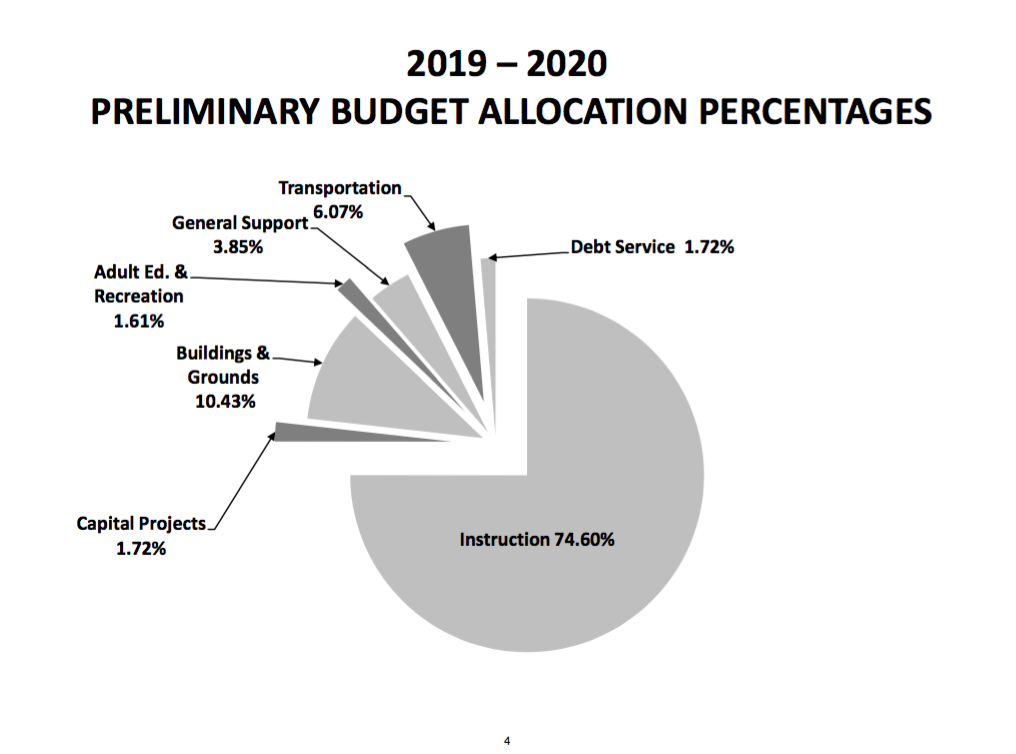Great Neck Public Schools administrators pitched a preliminary district budget of $233.64 million Monday night, describing it as a plan that stays well under the tax cap while maintaining the quality of schools districtwide.
Overall the proposed budget, if unchanged, would increase 1.65 percent, or just shy of $3.8 million, from the current $229.84 million. Paired with this is increasing the property tax levy by almost $3.95 million, or 1.94 percent, from $203.57 million to $207.52 million.
About 82 percent of the budget goes toward programming, with $192.39 million going toward things like teacher salaries, benefits, supervisors, instructional materials and other items.
Another 12 percent, or $28.52 million, goes toward capital projects separate from a $68.3 million bond issue approved in 2017, while administrative costs make up $12.72 million, or 6 percent of the total budget.
Superintendent of Schools Teresa Prendergast said the budget is not final and has not been adopted by the Great Neck Board of Education.
“I can tell you it is a fluid budget,” Prendergast said.
John Powell, the assistant superintendent for business, said the tax levy increase of 1.94 percent theoretically could have been more than double that at 4.09 percent.
This is because the $42 million in planned borrowing for capital projects related to the 2017 bond issue, and a higher tax base growth factor would have allowed the schools to issue a larger increase, Powell said.
Powell said that right now it was unclear how much state aid the district would get because state revenue projections were off by about $2.3 billion.
“We’re getting mixed signals,” Powell said.
The district also pursues grants to help defray costs, Powell said. In total the district expects to get $4.25 million worth of assistance.
There are also other alternative revenue streams like payments in lieu of taxes, expected to be about $7.54 million, $2 million from tuition from other school districts, $500,000 from interest on deposits, which is double what they projected last year, and $765,000 from adult education programs – a projection revised downward by $215,000 from last year.
The district also expects to take in $706,134 from rental of facilities, up from $467,342 last year, due to the district renting out a vacant property to Helms Brothers for about $20,000 a month, Powell said.
As for revenue on interest, Powell said this projection was in light of increasing interest rates.
Powell said that this year the district will have to pay 8.86 percent toward teacher retirement costs, down nearly 2 percentage points from 10.63 percent in 2018-19 and down more than 4 percentage points from 13.26 percent in 2015-16.
This translates to a considerable $2 million decrease in costs, Powell said.
“This is a big help in the proposed 2019-20 budget,” Powell said.
The next budget discussion will take place on Saturday, March 23, at 9:30 a.m. at South High School, where there will be a line-by-line budget review.
After that, there will be an informal hearing Monday, April 1, at 7:30 p.m. at South High School.
The official hearing and adoption of the budget will take place Tuesday, April 16, at 7:30 p.m. in North Middle School, before administrators discuss the official budget on Monday, May 13, at 7:30 p.m.
In unrelated business, about half a dozen people also raised concerns about the proposed parking lot for North High School, which would add 97 parking stalls and was approved as part of the $68.3 million bond issue in 2017.
Among their concerns were a lack of transparency from the Board of Education, too little hard data on why this parking lot is necessary, the message it would send to students and a belief that there are possible educational uses for the green space.



